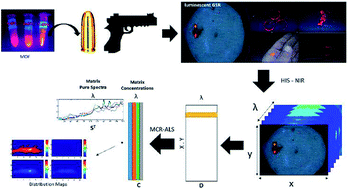NIR hyperspectral images for identification of gunshot residue from tagged ammunition†
Abstract
Analysis of gunshot residues (GSR) is a vital point of interest in forensic chemistry. GSR analysis is very well established, but there is still a lack of methodology to identify GSR obtained from lead-free or ‘non-toxic ammunition’ (NTA). To identify GSR from NTA, we have proposed the incorporation of luminescent markers to provide an optical and chemical signature to GSR. Furthermore, the luminescent markers can open up prospectives for ammunition encoding by adjusting their composition. Herein, we report the distinction among GSR particles containing different MOF-based markers by analyzing their organic fractions using near-infrared hyperspectral imaging (NIR-HSI) together with multivariate analysis (MCR-ALS). The method has been proven to be effective, non-destructive and fast in distinguishing marked GSR. It is possible to detect and correctly identify 72.2% of the samples, and all cases of misclassification are related to slight amount of material collected (8.3%) or confusion caused by one of the markers (19.4%). The study is developed in a forensic context of GSR analysis; however, the methodology described here is excellent and can be extrapolated to other applications that require distinguishing MOFs with different ligands.



 Please wait while we load your content...
Please wait while we load your content...